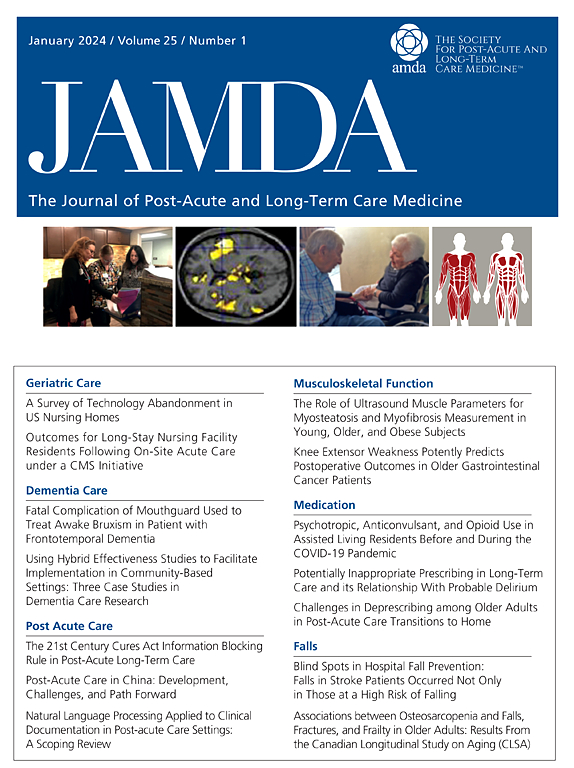Household Air Pollution, Physical Activity, and the Risk of Frailty Among Middle-Aged and Older Adults: A Cohort Study
IF 4.2
2区 医学
Q2 GERIATRICS & GERONTOLOGY
Journal of the American Medical Directors Association
Pub Date : 2025-04-29
DOI:10.1016/j.jamda.2025.105525
引用次数: 0
Abstract
Objective
This study aims to explore the relationship among household air pollution, physical activity (PA), and the risk of frailty among middle-aged and older adults.
Design
Prospective cohort study.
Setting and Participants
A total of 10,561 participants from the 2011–2020 China Health and Retirement Longitudinal Study (CHARLS) were included.
Methods
PA was assessed using the International Physical Activity Questionnaire (IPAQ), and household air pollution was measured based on cooking and heating. Frailty risk was evaluated using the frailty index (FI). Cox proportional hazards regression models were used for statistical analysis.
Results
During the follow-up, 1101 participants developed frailty. After adjusting for all covariates, compared with participants who consistently used solid fuels, transforming solid fuels to cleaner fuels for cooking [hazard ratio (HR), 0.671; 95% CI, 0.560–0.803] and heating (HR, 0.373; 95% CI, 0.292–0.479) reduced the risk of frailty by 32.9% and 62.7%, respectively. Conversely, transforming cleaner fuels to solid fuels for cooking increased the risk of frailty by 27.5% (HR, 1.275; 95% CI, 1.006–1.599). Sufficient PA for 3 to 4 years (HR, 0.658; 95% CI, 0.542–0.798) and for ≥5 years (HR, 0.490; 95% CI, 0.398–0.602) reduced frailty risk by 34.2% and 51.0%, respectively. Both transforming solid household fuels to cleaner household fuels with 3 or more years of sufficient PA and transforming cleaner household fuels to solid household fuels with 3 or more years of sufficient PA were significantly associated with lower frailty risk.
Conclusions and Implications
Both transforming solid household fuels to cleaner household fuels and maintaining sufficient PA for 3 or more years were significantly associated with lower risk of frailty. Conversely, transforming cooking-related cleaner fuels to cooking-related solid fuels can increase frailty risk. In addition, 3 or more years of sufficient PA can superimpose the benefits of transforming solid household fuels to cleaner household fuels, offsetting the negative effects of transforming cleaner household fuels to solid household fuels.
家庭空气污染、体力活动与中老年人的虚弱风险:一项队列研究。
目的:本研究旨在探讨家庭空气污染、身体活动(PA)与中老年人群虚弱风险之间的关系。设计:前瞻性队列研究。背景和参与者:2011-2020年中国健康与退休纵向研究(CHARLS)共纳入10,561名参与者。方法:采用国际身体活动问卷(IPAQ)对空气质量进行评估,并以烹饪和取暖为基础对家庭空气污染进行测量。用衰弱指数(FI)评价衰弱风险。采用Cox比例风险回归模型进行统计分析。结果:在随访期间,1101名参与者出现虚弱。在调整所有协变量后,与一直使用固体燃料的参与者相比,将固体燃料转化为更清洁的燃料进行烹饪(风险比[HR], 0.671;95% CI, 0.560-0.803)和加热(HR, 0.373;95% CI, 0.292-0.479)分别降低了32.9%和62.7%的衰弱风险。相反,将清洁燃料转化为用于烹饪的固体燃料会使脆弱的风险增加27.5% (HR, 1.275;95% ci, 1.006-1.599)。足够3 ~ 4年的PA (HR, 0.658;95% CI, 0.542-0.798)和≥5年(HR, 0.490;95% CI, 0.398-0.602)分别降低了34.2%和51.0%的衰弱风险。将固体家用燃料转化为具有3年或更长时间充足PA的更清洁的家用燃料,以及将更清洁的家用燃料转化为具有3年或更长时间充足PA的固体家用燃料,都与较低的脆弱性风险显著相关。结论和意义:将固体家用燃料转化为更清洁的家用燃料和维持足够的PA 3年或更长时间与较低的虚弱风险显著相关。相反,将与烹饪有关的清洁燃料转变为与烹饪有关的固体燃料可能会增加脆弱的风险。此外,3年或更长时间的充足PA可以叠加将固体家用燃料转变为更清洁的家用燃料的好处,抵消将更清洁的家用燃料转变为固体家用燃料的负面影响。
本文章由计算机程序翻译,如有差异,请以英文原文为准。
求助全文
约1分钟内获得全文
求助全文
来源期刊
CiteScore
11.10
自引率
6.60%
发文量
472
审稿时长
44 days
期刊介绍:
JAMDA, the official journal of AMDA - The Society for Post-Acute and Long-Term Care Medicine, is a leading peer-reviewed publication that offers practical information and research geared towards healthcare professionals in the post-acute and long-term care fields. It is also a valuable resource for policy-makers, organizational leaders, educators, and advocates.
The journal provides essential information for various healthcare professionals such as medical directors, attending physicians, nurses, consultant pharmacists, geriatric psychiatrists, nurse practitioners, physician assistants, physical and occupational therapists, social workers, and others involved in providing, overseeing, and promoting quality

 求助内容:
求助内容: 应助结果提醒方式:
应助结果提醒方式:


